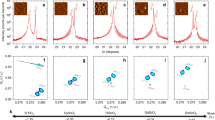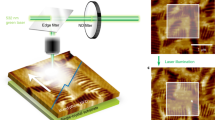Abstract
Multiferroic materials, which offer the possibility of manipulating the magnetic state by an electric field or vice versa, are of great current interest. In this work, we demonstrate the first observation of electrical control of antiferromagnetic domain structure in a single-phase multiferroic material at room temperature. High-resolution images of both antiferromagnetic and ferroelectric domain structures of (001)-oriented multiferroic BiFeO3 films revealed a clear domain correlation, indicating a strong coupling between the two types of order. The ferroelectric structure was measured using piezo force microscopy, whereas X-ray photoemission electron microscopy as well as its temperature dependence was used to detect the antiferromagnetic configuration. Antiferromagnetic domain switching induced by ferroelectric polarization switching was observed, in agreement with theoretical predictions.
This is a preview of subscription content, access via your institution
Access options
Subscribe to this journal
Receive 12 print issues and online access
$259.00 per year
only $21.58 per issue
Buy this article
- Purchase on Springer Link
- Instant access to full article PDF
Prices may be subject to local taxes which are calculated during checkout





Similar content being viewed by others
References
Fiebig, M. Revival of the magnetoelectric effect. J. Phys. D 38, R123–R152 (2005).
Spaldin, N. A. & Fiebig, M. The renaissance of magnetoelectric multiferroics. Science 309, 391–392 (2005).
Eerenstein, W., Mathur, N. D. & Scott, J. F. Multiferroic and magnetoelectric materials. Nature 442, 759–765 (2006).
Fiebig, M., Lottermoser, Th., Fröhlich, D., Goltsev, A. V. & Pisarev, R. V. Observation of coupled magnetic and electric domains. Nature 419, 818–820 (2002).
Lottermoser, Th. et al. Magnetic phase control by an electric field. Nature 430, 541–544 (2004).
Nan, C. W., Liu, G., Liu, Y. & Chen, H. Magnetic-field-induced electric polarization in multiferroic nanostructures. Phys. Rev. Lett. 94, 197203 (2005).
Ascher, E., Rieder, H., Schmid, H. & Stössel, H. Some properties of ferromagnetoelectric nickel-iodine boracite, Ni3B7O13I. J. Appl. Phys. 37, 1404–1405 (1966).
Shastry, S., Srinivasan, G., Bichurin, M. I., Petrov, V. M. & Tatarenko, A. S. Microwave magnetoelectric effects in single crystal bilayers of yttrium iron garnet and lead magnesium niobate-lead titanate. Phys. Rev. B 70, 064416 (2004).
Zheng, H. et al. Multiferroic BaTiO3-CoFe2O4 nanostructures. Science 303, 661–663 (2004).
Hill, N. A. Why are there so few magnetic ferroelectrics. J. Phys. Chem. 104, 6694–6709 (2000).
Kimura, T., Lawes, G. & Ramirez, A. P. Electric polarization rotation in a hexaferrite with long-wavelength magnetic structures. Phys. Rev. Lett. 94, 137201 (2005).
Kubel, F. & Schimid, H. Structure of a ferroelectric and ferroelastic monodomain crystal of the perovskite BiFeO3 . Acta Crystallogr. B 46, 698–702 (1990).
Fischer, P., Polomska, M., Sosnowska, I. & Szymanski, M. Temperature dependence of the crystal and magnetic structure of BiFeO3 . J. Phys. Solid State Phys. 13, 1931–1940 (1980).
Michel, C., Moreau, J.-M., Achenbach, G. D., Gerson, R. & James, W. J. The atomic structure of BiFeO3 . Solid State Commun. 7, 701–704 (1969).
Wang, J. et al. Epitaxial BiFeO3 multiferroic thin film heterostructures. Science 299, 1719–1722 (2003).
Dho, J., Qi, X., Kim, H., MacManus-Driscoll, J. L. & Blamire, M. G. Large electric polarization and exchange bias in multiferroic BiFeO3 . Adv. Mater. 18, 1445–1448 (2006).
Li, J. F. et al. Dramatically enhanced polarization in (001), (101), and (111) BiFeO3 thin films due to epitiaxial-induced transitions. Appl. Phys. Lett. 84, 5261–5263 (2004).
Yun, K. Y. et al. Structural and multiferroic properties of BiFeO3 thin films at room temperature. J. Appl. Phys. 96, 3399–3403 (2004).
Yun, K. Y., Noda, M. & Okuyama, M. Prominent ferroelectricity of BiFeO3 thin films prepared by pulsed-laser deposition. Appl. Phys. Lett. 83, 3981–3983 (2003).
Das, R. R. et al. Synthesis and ferroelectric properties of epitaxial BiFeO3 thin films grown by sputtering. Appl. Phys. Lett. 88, 242904 (2006).
Ederer, C. & Spaldin, N. A. Weak ferromagnetism and magnetoelectric coupling in bismuth ferrite. Phys. Rev. B 71, 060401(R) (2005).
Neaton, J. B., Ederer, C., Waghmare, U. V., Spaldin, N. A. & Rabe, K. M. First-principles study of spontaneous polarization in multiferroic BiFeO3 . Phys. Rev. B 71, 014113 (2005).
Thole, B. T., van der Laan, G. & Sawatzky, G. A. Strong magnetic dichroism predicted in the M4,5 X-ray absorption spectra of magnetic rare-earth materials. Phys. Rev. Lett. 55, 2086–2088 (1985).
Czekaj, S., Nolting, F., Heyderman, L. J., Willmott, P. R. & van der Laan, G. Sign dependence of the X-ray magnetic linear dichroism on the antiferromagnetic spin axis in LaFeO3 thin films. Phys. Rev. B 73, 020401(R) (2006).
Bai, F. et al. Destruction of spin cycloid in (111)c-oriented BiFeO3 thin films by epitaxial constraint: Enhanced polarization and release of latent magnetization. Appl. Phys. Lett. 86, 032511 (2005).
Zavaliche, F. et al. Ferroelectric domain structure in epitaxial BiFeO3 films. Appl. Phys. Lett. 87, 182912 (2005).
Zavaliche, F. et al. Polarization switching in epitaxial BiFeO3 films. Appl. Phys. Lett. 87, 252902 (2005).
Scholl, A. et al. Observation of antiferromagnetic domains in epitaxial thin films. Science 287, 1014–1016 (2000).
Scholl, A., Ohldag, H., Nolting, F., Stöhr, J. & Padmore, H. A. X-ray photoemission electron microscopy, a tool for the investigation of complex magnetic structures (invited). Rev. Sci. Instrum. 73, 1362–1366 (2002).
Luning, J. et al. Determination of the antiferromagnetic spin axis in epitaxial LaFeO3 films by x-ray magnetic linear dichroism spectroscopy. Phys. Rev. B 67, 214433 (2003).
Yang, W. C., Rodriguez, B. J., Gruverman, A. & Nemanich, R. J. Polarization-dependent electron affinity of LiNbO3 surfaces. Appl. Phys. Lett. 85, 2316–2318 (2004).
Tsuboi, T. Linear dichroism study of the structural phase transition of BaMnF4 . Phys. Rev. B 39, 2842–2845 (1989).
Ederer, C. & Spaldin, N. Effect of epitaxial strain on the spontaneous polarization of thin film ferroelectrics. Phys. Rev. Lett. 95, 257601 (2005).
Ederer, C. & Spaldin, N. Influence of strain and oxygen vacancies on the magnetoelectric properties of multiferroic bismuth ferrite. Phys. Rev. B 95, 224103 (2005).
Acknowledgements
This work is supported by an ONR grant No. N00014-06-1-0008, N00014-05-1-0559 (CBE) monitored by Colin Wood and an ONR-MURI grant No. E-21-6RU-G4. This work was also supported by the National Science Foundation under grants DMR-0313764 (CBE) and ECS-0210449 (CBE) and a David & Lucile Packard Fellowship (CBE). Partial support from a LBL LDRD and a MARCO program is also gratefully acknowledged. C.E. and N.A.S. are supported by the NSF’s ‘Chemical Bonding Centers’ program, grant No. CHE-0434567 and made use of the central facilities provided by the NSF-MRSEC Award No. DMR05-20415.
Author information
Authors and Affiliations
Corresponding authors
Ethics declarations
Competing interests
The authors declare no competing financial interests.
Rights and permissions
About this article
Cite this article
Zhao, T., Scholl, A., Zavaliche, F. et al. Electrical control of antiferromagnetic domains in multiferroic BiFeO3 films at room temperature. Nature Mater 5, 823–829 (2006). https://doi.org/10.1038/nmat1731
Received:
Accepted:
Published:
Issue Date:
DOI: https://doi.org/10.1038/nmat1731
This article is cited by
-
Multiferroic and photocatalytic properties of DyFeO3 nanoparticles stabilized by citrate precursor route
Bulletin of Materials Science (2024)
-
Direct observation of intrinsic room-temperature ferroelectricity in 2D layered CuCrP2S6
Nature Communications (2023)
-
Ultrafast terahertz emission from emerging symmetry-broken materials
Light: Science & Applications (2023)
-
Electric-field control of topological spin textures in BiFeO3/La0.67Sr0.33MnO3 heterostructure at room temperature
Rare Metals (2023)
-
Studies of Structural, Microstructure, Dielectric and Optical Properties of Bismuth-Based Complex Perovskite Modified Bismuth Ferrite: BiFeO3–(Bi0.5Na0.25K0.25)(Ti0.5Mn0.5)O3 Ceramics
Transactions on Electrical and Electronic Materials (2023)



